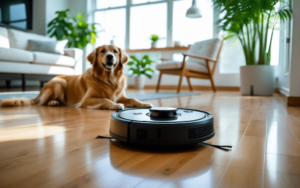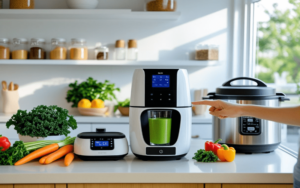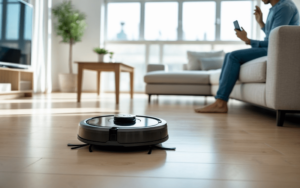Pet owners know just how tough it is to keep their homes free of fur, dander, and dust. Even with regular cleaning, those tiny particles seem to hang around, causing allergies and lingering odors.
Using the best air purifier for pets and dust can really improve air quality and make home feel healthier for everyone.

Air purifiers are built to trap small particles like pet hair, dander, and dust. Families get relief from sneezing, coughing, and stuffy noses.
Some models, like the Rabbit Air A3 Ultra Quiet HEPA Air Purifier, do a great job at removing not just dust and allergens, but also those stubborn pet smells. Picking the right air purifier can make living with pets easier and keep the air smelling fresh.
Please note that this article contains affiliate links. As an Amazon Associate, we earn from qualifying purchases at no extra cost to you.
Find selection of best air purifiers klick here
Key Takeaways
- Air purifiers help reduce pet dander and dust from indoor air.
- Certain models work better for pet homes by removing odors and particles.
- Proper care and placement improve air purifier performance.
Why Air Purifiers Matter for Pet Owners
Pet owners often deal with extra dust, dander, and odors at home. Breathing cleaner air can help both humans and pets feel better and stay healthier.
Common Air Quality Challenges in Homes With Pets
Pets shed fur, skin flakes (dander), and track in dirt from outside. These particles float in the air and settle on every surface.
For people with allergies or asthma, pet dander is a common trigger. Litter boxes and pet cages can add strong odors into the mix.
Even if pets get groomed regularly, cleaning might not catch everything in the air. Some breeds shed more than others, so dust and hair can build up fast.
Homes with pets also see a spike in airborne allergens and tiny bits like dust mites. Air purifiers made for pet homes use filters that trap up to 99.97% of small particles, including dander and dust. There’s some good advice about this on removing pet hair and dander.
Health Benefits of Cleaner Air for You and Your Pets
Cleaner air helps people and pets breathe easier. Less dander and dust in the air means fewer allergy symptoms—think less sneezing, itchy eyes, or runny nose.
Pets can struggle with poor air quality too. Cats and dogs might cough or wheeze if dust and allergens are high.
Cleaner air can make a real difference for animals with breathing issues, like cats with asthma. Using the right air purifier supports both human and pet health by lowering the odds of breathing problems.
Research shows that air purifiers can remove harmful particles and boost overall well-being for everyone in the home. This is especially important if someone has allergies, asthma, or pets who are sensitive to dust.
How Dust and Pet Dander Affect Indoor Air
Dust and pet dander are two of the biggest triggers for indoor allergies and breathing issues. Both can pile up fast, messing with air quality and comfort at home.
Understanding Pet Dander and Allergens
Pet dander is tiny flakes of skin, fur, or feathers from animals like cats and dogs. These bits are so light, they stay in the air for ages.
Even homes without pets can have pet allergens, since dander can hitch a ride on clothing or shoes. For folks with allergies or asthma, breathing in dander can mean sneezing, itchy eyes, or trouble catching a breath.
Proteins in pet saliva, urine, and dander often set off allergic reactions. Dander is so fine, you usually can’t see it—making it tough to remove without the right tools. Air purifiers made for pet owners filter out dander and other allergens, which helps cut down on symptoms and makes for a healthier home.
Studies show air filtration works well for removing pet and dust allergens from indoor air. If you’re curious, there’s more on this in an article about how air purifiers remove pet dander and allergens.
Sources of Household Dust
Household dust is a mix of all sorts of stuff—dead skin cells, hair, fabric fibers, pollen, soil, and even tiny bits of plastic. Pet dander can sneak in there too, so it’s not just a problem for pet owners.
Most dust comes from daily activities: walking, cleaning, opening windows. It settles on floors, furniture, and electronics.
Dust mites, which can trigger allergies, love high-dust spots. Cleaning helps, but wiping and sweeping just send dust back into the air sometimes.
Air purifiers with strong filters trap these particles, so there’s less left floating around to breathe in. There’s a handy guide on controlling indoor allergens and improving air quality if you want more tips.
Key Features of the Best Air Purifiers for Pets and Dust
The best air purifiers for homes with pets and dust use advanced filtration and smart features to boost indoor air quality. They help people breathe easier by removing pet dander, trapping odors, and letting you know when to swap out filters.
HEPA Filtration for Pet Allergens
True HEPA filters are a must for pet owners. They catch particles as small as 0.1 microns—pet dander, dust, pollen, you name it.
This leads to less sneezing and a cleaner home, especially if your pets shed a lot. HEPA filters can trap up to 99.97% of airborne particles.
This type of filtration is recommended for anyone with allergies or asthma. Many top-rated air purifiers use it to keep homes healthier for both people and pets.
Another plus: HEPA filters grab tiny particles that regular cleaners miss. There’s more in-depth info in guides about HEPA filtration for pets.
We may earn a small commission if you purchase through this link. Thank you for supporting our content!
Activated Carbon for Odor Control
Activated carbon filters soak up smells from pets, cooking, and smoke. These filters work by absorbing odor molecules and chemicals in the air.
Pet owners often notice a big difference within just a few days of using a purifier with carbon filtration. The best air purifiers have multi-stage filtration, usually combining HEPA and activated carbon in one unit, so you get dust and odor control in one go.
Activated carbon is especially helpful in homes with litter boxes, wet dogs, or young pets still learning the rules. Here’s a quick look at what activated carbon can handle:
| Odor Type | Removed by Carbon Filter? |
|---|---|
| Pet Accidents | Yes |
| Litter Box Smells | Yes |
| Smoke | Yes |
| Cooking Smells | Yes |
If you want to dig deeper, check out testing results for air purifiers with carbon filters for pets.
Filter Replacement Indicators
Air purifiers only work well if their filters are changed on time. Built-in filter replacement indicators help you remember when it’s time to swap out the HEPA or carbon filter.
This takes the guesswork out of maintenance. A clear indicator is important for busy households—when a light or alert pops up, you know it’s time to act before air quality drops.
Some displays even show how many hours or days are left, using simple icons. Smart filter indicators usually show up on higher-quality purifiers, which makes upkeep less stressful.
For more detail on models with this feature, see recommendations from review sites for best air purifiers.
Top Recommended Air Purifier Models for Homes With Pets
Finding the right air purifier for homes with pets means looking for machines that actually remove pet hair, dander, and dust. Some models work best for big rooms, while others fit smaller spaces or tighter budgets.
Best Overall Performance
The Rabbit Air A3 stands out for its ability to clean air in homes with multiple pets. It uses a strong HEPA filter to trap dander, dust, pollen, and even mold spores.
The design is slim, and it can be mounted on a wall or just sit on the floor. Users can set it to run quietly at night, which is a relief for light sleepers.
Allergy sufferers often notice easier breathing and less dust on surfaces. It’s got smart features that let you adjust settings from your phone, which is honestly pretty handy.
In tests, the Rabbit Air A3 scored high for particle removal and quiet operation. It’s a solid pick for families who want powerful cleaning and easy control. More details are in this review of best air purifiers for pets.
Best for Large Rooms
Got a big living room or an open floor plan? The Blueair Blue Pure 211+ is honestly a solid option for those larger spaces.
This machine covers up to 540 square feet and cycles the air several times an hour. It’s got a three-part filtration setup that grabs pet hair, odors, and dust.
The washable fabric pre-filter catches bigger fur before it even hits the main filter. It’s surprisingly quiet, even when you crank it up.
Plenty of pet owners say it clears up smells and floating fur pretty quickly—sometimes in just a few hours.
The touch-button controls are simple, and the design is compact enough to fit almost anywhere. If you want to compare it to others, this list of top pet air purifiers covers similar models.
Best for Small Spaces
For small apartments or bedrooms, you want something that works but doesn’t eat up all your floor space. The Levoit Core series is a go-to for pet owners in tight quarters.
It’s quiet enough for nighttime use, so you and your pets can actually sleep. The true HEPA filter traps up to 99.97% of tiny stuff—dust, dander, and even some bacteria.
Air gets circulated fast, so the room stays fresher. It’s lightweight, too, so you can move it around easily if you want.
Curious how it holds up with pets? There’s a pretty honest Levoit pet air purifier review worth checking out.
Budget-Friendly Picks
If you’re looking to keep the air clean without spending a fortune, there are some good picks. The GermGuardian Airsafe+ is affordable but still offers HEPA-grade filtration.
It knocks down pet odors, traps dander, and cuts down on dust. The compact size works for offices, nurseries, or just that extra room you never know what to do with.
The filter lasts several months before you have to swap it, which saves money over time. There’s even an optional UV-C light if you want a bit more germ control.
Other budget models keep things simple with easy filter changes and basic controls. You can find more options in this guide to pet air purifiers.
We may earn a small commission if you purchase through this link. Thank you for supporting our content!
Comparing Air Purifier Technologies
Air purifiers use different methods to catch dust, dander, and whatever else is floating around. Some use filters to trap particles, while others rely on light or ions to break down germs or clear out pollutants.
True HEPA vs. HEPA-Type Filters
HEPA stands for High-Efficiency Particulate Air. True HEPA filters have to trap at least 99.97% of particles as tiny as 0.3 microns.
That means they catch pet dander, dust mites, pollen, and even some bacteria. These filters are a must if you have allergies or asthma.
HEPA-Type filters (sometimes called “HEPA-like”) just don’t meet the same standard. They usually trap about 90-95% of particles, but not the tiniest stuff.
If you’ve got pets, True HEPA is the way to go for catching fine hair and dander. Always check the label for “True HEPA” if you want the best performance.
Here’s a quick side-by-side:
| Filter Type | Best for | Capture Rate |
|---|---|---|
| True HEPA | Allergies, Pets | 99.97% (0.3 microns) |
| HEPA-Type | General Dust | ~90-95% (larger) |
UV-C Light and Ionizers
Some purifiers add extras like UV-C lights or ionizers. UV-C kills certain germs and bacteria by messing with their DNA, but it doesn’t remove dust or pet hair.
It’s really just for germs, not for trapping particles. Ionizers send out charged particles that make dust and dander clump together and fall—or stick to a plate inside the machine.
Ionizers can help, but they sometimes create a smell or even a bit of ozone, which isn’t great if you (or your pets) are sensitive. Most people are better off with a solid True HEPA filter, and only use UV-C or ionizer features if you’re worried about germs.
For homes with pets, filters do way more than UV-C or ionizers. Those features are mostly for germs, not fur or dander.
Placement Tips for Maximum Effectiveness

Where you put your air purifier can make a surprising difference. Airflow, pets, and the shape of your rooms all matter here.
Ideal Locations in Pet-Friendly Homes
Try to keep the purifier in a central spot so it can pull in dust and pet hair from every corner. Don’t shove it against the wall, behind the couch, or in a cramped corner—give it about a foot of space all around.
Setting it off the floor and away from pet beds or food bowls helps keep fur from clogging things up. If your pets hang out in certain rooms, those are the best places to put the unit.
Living rooms and bedrooms are usually smart choices. Putting the purifier near problem zones—like litter boxes or favorite napping spots—can help too.
Need more ideas? Here are some placement tips for pet owners.
Room Coverage Considerations
Always check the coverage area before you turn on your air purifier. Most brands list the max square footage they can handle.
If your purifier is too small for the space, it just won’t keep up. For big rooms, get a model rated for the whole area, or consider using two smaller ones together.
In open floor plans, put the purifier where your pets spend most of their time. Keeping doors open lets more air move through, but some models work better with doors and windows closed—so peek at the manual for what’s best.
Want to match your purifier to your room? Here are some air purifier placement tips. If you notice dust or smells coming back fast, you might need to move things around or size up your purifier.
Maintenance and Care for Your Air Purifier
Keeping up with maintenance helps your air purifier work better and last longer. It’s pretty simple stuff, but it can also save you money on energy and keep your home fresher.
Cleaning Schedules
Set a regular cleaning routine so dust and pet hair don’t block the filters or vents. Most brands suggest wiping the outside down with a damp cloth once a week to catch the dust and fur.
Vacuum the intake and outflow grilles weekly, too, just to keep things from piling up. Many purifiers have pre-filters inside that catch bigger stuff—take these out and wash or vacuum them every two to four weeks, depending on how much your pets shed.
If you’ve got allergies or a heavy-shedding pet, you’ll want to clean a bit more often. Some models, like the Air Oasis iAdaptAir, suggest checking all the filter parts regularly, especially if you run the unit daily.
Honestly, keeping a little checklist or reminder on your calendar helps a lot.
Suggested Cleaning Tasks:
| Task | How Often |
|---|---|
| Wipe exterior | Weekly |
| Vacuum air vents | Weekly |
| Clean/wash pre-filter | 2-4 weeks |
| Inspect all filters | Monthly |
Replacing Filters
Every air purifier needs its filters swapped out once they’re full of dust, dander, or odors. HEPA filters in models like the Coway Airmega AP-1512HH Mighty usually last 6-12 months, but it really depends on the brand and how much you use it.
Carbon filters that handle smells might need changing every 3-6 months, especially if you’ve got pets. Some purifiers have indicator lights to tell you when it’s time, but always follow the manual’s advice for your model.
Using the wrong filter can make the purifier less effective, so stick to the right ones for your device. Swapping filters on time keeps things running smoothly and your air cleaner.
Frequently Asked Questions
A lot of people wonder if air purifiers actually help with pet allergies and dust. Knowing which features matter and how to care for your machine makes a big difference.
What features should I look for in an air purifier to combat pet allergies?
You’ll want a true HEPA filter for catching those tiny dander particles. Make sure the clean air delivery rate (CADR) matches your room size.
Pre-filters help with bigger stuff like hair, and activated carbon filters are great for trapping odors. Multiple fan speeds and quiet operation make daily use more pleasant.
How effective are air purifiers at removing pet hair and dander?
A good purifier with a HEPA filter can grab up to 99.97% of tiny particles, including pet dander. Pre-filters usually catch most of the hair before it clogs things up.
Some units, like the Rabbit Air MinusA2 and IQAir HealthPro Series, use layered filters for even better results. They trap both hair and microscopic allergens before they can circulate around your home.
Can air purifiers help alleviate asthma symptoms triggered by pets?
Air purifiers with true HEPA filters can help cut down on allergens like pet dander and dust, which might make breathing easier for people with asthma. They can improve air quality, but they’re not a magic fix for every trigger.
Regular cleaning and keeping pets out of bedrooms still matter a lot. But if you’re sensitive to airborne stuff, an air purifier is definitely worth a try.
What are the top-rated air purifiers for dealing with both pets and dust, according to consumer reports?
Some top picks? The Rabbit Air MinusA2 and IQAir HealthPro Series. Both use multi-stage filtration to tackle dander, dust, and odors.
The best models remove allergens, odors, and pet hair pretty fast and don’t make a fuss about it.
Other brands put a lot of focus on strong HEPA filters and solid CADR ratings. Quiet operation is a big plus, too.
If you’re researching, check reviews that talk about real-life performance in homes with pets. That’s where you’ll find the honest details.
Are there any air purifiers with washable filters that are suitable for homes with pets?
Yep, some air purifiers do include washable pre-filters. These washable bits grab bigger stuff like fur and hair, which means your main HEPA filter lasts longer.
Just keep in mind, true HEPA filters themselves usually aren’t washable. If you want convenience and strong performance, look for models with both washable pre-filters and replaceable HEPA filters. That combo tends to work well for pet owners.
How often should I replace my air purifier’s filter in a home with pets?
Manufacturers usually suggest swapping out HEPA filters every 6 to 12 months. If you’ve got a couple of furry friends running around, you might be looking at changing them as often as every 3 to 6 months.
Washable pre-filters? Those should really get a rinse every few weeks, or even more often if things get hairy—literally. It’s always smart to double-check your manual, though; every air purifier seems to have its own quirks.
This article contains affiliate links, which means we may earn a commission if you purchase through our links, at no extra cost to you. As an Amazon Associate, we earn from qualifying purchases. Thank you for supporting our content!
Shop your best air purifier here




